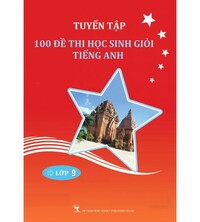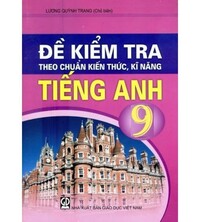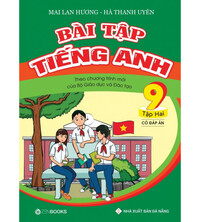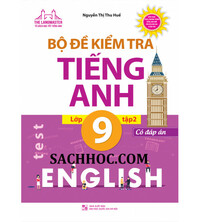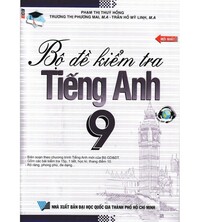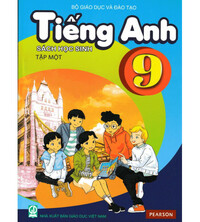Test Yourself 2 - Kiểm tra cá nhân 2 - trang 56 - SBT tiếng Anh 9 mới
Match the sentences (1-10) with the sentences that have roughly the same meaning (A-J). Underline all the words that are stressed in the sentences (1-10). (2 p). Nối các câu 1-10 với nghĩa tương ứng A-J. Gạch dưới các từ nhấn mạnh trong câu 1-10.
Bài 1
Task 1. Match the sentences (1-10) with the sentences that have roughly the same meaning (A-J). Underline all the words that are stressed in the sentences (1-10). (2 p).
(Nối các câu 1-10 với nghĩa tương ứng A-J. Gạch dưới các từ nhấn mạnh trong câu 1-10.)

Lời giải chi tiết:
| 1 – E | 2 – H | 3 – A | 4 – J | 5 – G |
| 6 – B | 7 – I | 8 – F | 9 – D | 10 – C |
a. Nối các câu 1-10 với nghĩa tương ứng A-J
1. Who do you take after? - Who do you resemble?
Tạm dịch:Bạn trông giống ai ? - Bạn giống ai?
2. You should take out 'quality'. - The word 'quality’ should be omitted.
Tạm dịch: Bạn bỏ qua 'chất lượng'. - Từ 'chất lượng nên được bỏ qua.
3. This is the man you have to talk to. - He's the man you should consult.
Tạm dịch: Đây là người đàn ông bạn phải nói chuyện .- Anh ấy là người đàn ông bạn nên tham khảo.
4. You mustn't smoke in here. - You are not allowed to smoke in here.
Tạm dịch: Bạn không được hút thuốc ở đây. - Bạn không được phép hút thuốc ở đây.
5. I didn't email him. - I only sent him a text message.
Tạm dịch: Tôi đã không gửi email cho anh ấy. - Tôi chỉ gửi cho anh ấy một tin nhắn.
6. I do hope you enjoy yourself. - I really hope you have a good time.
Tạm dịch: Tôi hy vọng bạn thích chính mình. - Tôi thực sự hy vọng bạn có một thời gian tốt.
7. She has finished the essay, but I haven't.- I am worrying about the essay.
Tạm dịch: Cô ấy đã hoàn thành bài luận, nhưng tôi chưa.- Tôi lo lắng về bài luận.
8. Put that down! - Don't keep holding that!
Tạm dịch: Đặt nó xuống! - Đừng tiếp tục giữ nó!
9. Remember to wash it! - Don't forget to clean it!
Tạm dịch: Nhớ rửa đi! - Đừng quên làm sạch nó!
10. Watch out, boy! - Be careful, boy!
Tạm dịch: Coi chừng, chàng trai! - Cẩn thận, chàng trai!
b. Gạch dưới các từ nhấn mạnh trong câu 1-10.
1. Who, take, after
2. take, quality
3. the, man, talk, to
4. mustn't, smoke, here
5. didn't, email
6. do, hope, enjoy
7. finished, essay, haven't
8. Put, that, down
9. Remember, to, wash, it
Bài 2
1. It is important to____the wonders of the world so that future generations can see them their own eyes.
A. destroy B. ignore
C. remain D preserve
2. You don't have to go to a supermarket for that. Just wait for a street___________ to go past, and buy
A. person B. vendor
C. supplier D. purchaser
3. Production methods in the village are normally_________ from ancestors to the younger generation.
A. passed away B. passed out
C. passed up D. passed down
4. It is important to decide if promotion should be based on merit or___________ .
A. gender B. year
C. seniority D. weight
5. It's a great experience to be sitting comfortably in a______streets.
A. bicycle B. rickshaw
C. car D. train
6. Working in a place full of hustle and bustle like this, I can’t help missing my tranquil and _______village.
A. picturesque B. modern
C. loud D. ugly
7. The scenery is______ when viewed from the mountain top. It feels like your breath is being taken
A. nice B. good
C. spectacular D. peaceful
8. _________by the sea, the country has the advantage of having a large coastal area.
A. Situating B. Located9. I love it when we go to see plays, and try to_________ when we get back home.
A. play B. role-play
C. act them out D. act
10. It is hard for people of different_________ to get along in an extended family.
A. generations B. genders
C blood D. families
Lời giải chi tiết:
1. It is important to preserve the wonders of the world so that future generations can see them their own eyes.
Giải thích: preserve (v): bảo tồn
Tạm dịch: Điều quan trọng là phải bảo tồn các kỳ quan của thế giới để các thế hệ tương lai có thể nhìn thấy chúng bằng chính đôi mắt của chúng.
2. You don't have to go to a supermarket for that. Just wait for a street vendor to go past, and buy
Giải thích: street vendor: người bán hàng rong
Tạm dịch: Bạn không cần phải đi siêu thị cho điều đó. Chỉ cần đợi một người bán hàng rong đi qua, và mua.
3. Production methods in the village are normally passed down from ancestors to the younger generation.
Giải thích:pass down: truyền lại
Tạm dịch: Phương thức sản xuất trong làng thường được truyền từ tổ tiên sang thế hệ trẻ.
4. It is important to decide if promotion should be based on merit or seniority.
Giải thích: seniority (n): thâm niên
Tạm dịch: Điều quan trọng là quyết định xem khuyến mãi nên dựa trên thành tích hay thâm niên.
5. It's a great experience to be sitting comfortably in a rickshaw street.
Giải thích: rickshaw: xe xích lô
Tạm dịch: Thật là một trải nghiệm tuyệt vời khi được ngồi thoải mái trên những chiếc xe kéo.
6. Working in a place full of hustle and bustle like this, I can’t help missing my tranquil and picturesque village.
Giải thích: picturesque (adj): đẹp như tranh
Tạm dịch: Làm việc ở một nơi đầy hối hả như thế này, tôi có thể giúp đỡ bỏ lỡ ngôi làng yên tĩnh và đẹp như tranh vẽ của mình.
7. The scenery is spectacular when viewed from the mountain top. It feels like your breath is being taken
Giải thích: spectacular (adj): ngoạn mục
Tạm dịch: Phong cảnh thật ngoạn mục khi nhìn từ đỉnh núi. Cảm giác như hơi thở của bạn đang bị lấy đi.
8. Located by the sea, the country has the advantage of having a large coastal area.
Giải thích: located by: nằm ở địa điểm...
Tạm dịch: Nằm cạnh biển, đất nước này có lợi thế là có một khu vực ven biển rộng lớn.
9. I love it when we go to see plays, and try to act them out when we get back home.
Giải thích: act them out: diễn
Tạm dịch: Tôi thích nó khi chúng tôi đi xem vở kịch, và cố gắng diễn chúng khi chúng tôi trở về nhà.
10. It is hard for people of different generations to get along in an extended family.
Giải thích: generation (n): thế hệ
Tạm dịch: Thật khó để những người thuộc các thế hệ khác nhau hòa nhập với nhau trong một đại gia đình.
Bài 3
Task 3. Choose the underlined word/phrase which is incorrect. (1 p)
(Chọn từ bị sai để sửa.)

Lời giải chi tiết:
| 1. A | 2. D | 3. A | 4. B | 5. A |
| 6. D | 7. C | 8. D | 9. A | 10. C |
1. A
Giải thích: used to + V nguyên thể
2. D
3. A
Giải thích: wish + QKD ==> điều ước hiện tại
4. B
Giải thích: wish + QKD ==> điều ước hiện tại
5. A
Giải thích: suggested + Ving --> gợi í làm gì
6. D
Giải thích: wonder
7. C
Giải thích: phải chuyển về bị động ==> have been replaced
8. D
Giải thích: took ==> take vì trước có động từ khuyết thiếu should
9. A
Giải thích: chủ ngữ số ít ==> động tù phải chia
10. C
Giải thích: phải chuyển về trạng từ để bổ ngữ cho động từ trước nó
Bài 4
Task 4. Put an appropriate word in each gap in the following passage. (2 p)
(Điền từ thích hợp vào chỗ trống.)
I still remember how we celebrated Tet when I was small. We used to live in an (1)______family, with our grandparents and our uncle's family.
Our family (2)________ to make banh chung Tet came. It was a busy, but wonderful, time for all of ú. My aunt used to be the one to clean dong leaves, the (3)______we used to wrap the cakes with. My uncle was the one to get water from the well for (4)________ to do the cleaning. My mom was always (5)______--for the preparation of the filling, which was made of green beans, and pork flavoured with onion and pepper. Normally, my grandfather did the wrapping, and we sat around watching him do it excitedly. We (6)______ also happy to be asked to fetch anything my grandpa needed. When the night fell, we started boiling the cakes, which (7)___________ about eight hours. It was hard to wait so long for them! We stayed up (8)_______________ the night, grilling sweet potatoes, listening to our grandpa's (9)_______ , and playing chess or cards. Now we have grown up, and are often too busy to make banh chung. But it remains a really sweet (10) _____ for us all.
Lời giải chi tiết:
| 1. extended | 2. used |
| 3. leaves | 4. her |
| 5. responsible | 6. were |
| 7. took | 8. throughout |
| 9. stories | 10. memory |
1. extended
Giải thích: Đằng sau là 1 danh từ ==>cần 1 tính từ để bổ nghĩa
2. used
Giải thích: used to + V nguyên thể ==> thói quen trong QK
3. leaves
Giải thích: trước chỗ trống có the ==> 1 danh từ
4. her
Giải thích: for her (cho cô ấy)
5. responsible
Giải thích: be + adj
6. were
Giải thích: danh từ số nhiều và hành động đang ở thì quá khứ
7. took
Giải thích: hành động đã xảy ra trong quá khứ
8. throughout
Giải thích: throughout qua
9. stories
Giải thích: Trước chỗ trống có sở hữu cách ==> 1 danh từ
10. memory
Giải thích: Đằng trước là tính từ ==> cần 1 danh từ để đảm bảo cấu trúc cụm danh từ
Tạm dịch:
Tôi vẫn nhớ chúng tôi đã tổ chức Tết như thế nào khi tôi còn nhỏ. Chúng tôi từng sống trong một gia đình lớn, với ông bà và gia đình chú tôi.
Gia đình tôi đã từng làm bánh chưng khi Tết đến. Đó là khoảng thời gian rất bận rộn với tất cả chúng tôi, nhưng rất tuyệt vời. Dì tôi là người rửa lá dong, những chiếc lá mà chúng tôi dùng để gói bánh. Chú tôi thì lấy nước từ giếng cho dì để rửa lá. Mẹ tôi luôn là người phụ trách chuẩn bị cho việc làm phần nhân, bao gồm đỗ xanh, thịt lợn ướp hành và tiêu. Thông thường, ông tôi gói bánh và chúng tôi ngồi xung quanh xem ông làm rất thích thú. Chúng tôi đã rất hạnh phúc khi được bảo đưa cho ông mọi thứ ông cần. Khi màn đêm buông xuống, chúng tôi bắt đầu luộc bánh, việc này tốn khoảng 8 tiếng. Thật khó để chờ lâu như vậy! Chúng tôi thức xuyên đêm, nướng khoai lang, lắng nghe những câu chuyện của ông và chơi cờ hoặc chơi bài. Giờ đây chúng tôi đều đã lớn, và thường quá bận rộn để có thể làm bánh chưng. Nhưng đó vẫn là những kỉ niệm ngọt ngào với chúng tôi.
Bài 5
Task 5. Read the passage and decide whether the statements are true (T) or false (F).
(Đọc đoạn văn sau và xem là câu đã cho đúng hay sai.)
Welcome to Thung Nham, the Ecotourism Bird Garden!
This area is in Ninh Hai commune, Hoa Lu district, Ninh Binh, North Viet Nam. Come, and you can enjoy a forty-minute boat ride on the river from Tam Coc, Bich Dong, to the small picturesque valley where the Bird Garden is located. The experience of floating past mangroves and water caves to the astoundingly vast garden will definitely bring you a feeling of deep satisfaction. The Bird Garden boasts forty-six varieties of bird, forty thousand specimens, and five thousand nests. Come and experience the beauty of the Buddha Cave, which is five-hundred metres long, seventy metres at its widest point, and thirty metres at its highest point. Exploring the cave, you will be deeply impressed by the images, especially the image of Buddha sitting by the underground river bringing good luck to visitors. And don't forget to climb up to Vai Gioi Cave, which is spectacularly located on a hilltop, eighty-eight metres above the ground.The cave covers up to five thousand square metres, and includes three levels representing Hell, Earth, and Heaven.
Tạm dịch:
Chào mừng đến với Thung Nham, Vườn chim du lịch sinh thái!
Khu vực này thuộc xã Ninh Hải, huyện Hoa Lư, tỉnh Ninh Bình, phía Bắc Việt Nam. Đến đây, và bạn có thể tận hưởng chuyến thuyền dài 40 phút trên sông từ Tam Cốc, Bích Động đến thung lũng nhỏ đẹo như tranh nơi vườn chim tọa lạc. Trải nghiệm được lướt nhẹ qua những cây đước và động nước tới khu vườn rộng đáng kinh ngạc sẽ chắc chắn mang tới cho bạn cảm giác thỏa mãn tuyệt vời. Vườn chim có 46 loại chim, 4000 cá thể và 5000 tổ chim. Hãy đến và trải nghiệm vẻ đẹp của Động Phật, dài 500m, rộng 70m và điểm cao nhất 30m. Khám phá hang động, bạn sẽ bị choáng ngợp bởi những hình ảnh, đặc biệt là hình ảnh Phật ngồi ở đáy sông đem đến sự may mắn cho khách du lịch. Và đừng quên trèo lên động Vai Gioi, hang động nằm trên một đỉnh đồi, cao 88m so với mặt đất. Hang động này bao phủ hơn 5000m2, và bao gồm 3 cấp độ thể hiện cho Địa ngục, Thế gian và Thiên đường.
Lời giải chi tiết:
| 1. T | 2. T | 3. F | 4. F | 5. T |
1. The area can be accessed by boat.
Đáp án: True
Giải thích: This area is in Ninh Hai commune, Hoa Lu district, Ninh Binh, North Viet Nam. Come, and you can enjoy a forty-minute boat-ride on the river from Tam Coc, Bich Dong,
2. On the way to the valley, visitors can enjoy the beauty of the mangroves and water caves.
Đáp án: True
Giải thích: The experience of floating past mangroves and water caves to the astoundingly vast garden will definitely bring you a feeling of deep satisfaction. T
3. The Bird Garden is very small and boring, with only a few different types of birds.
Đáp án: False
Giải thích: The Bird Garden boasts forty-six varieties of bird, forty thousand specimens, and five thousand nests.
4. The Buddha image shows the Buddha standing and giving luck to visitors.
Đáp án: False
Giải thích: Exploring the cave, you will be deeply impressed by the images, especially the image of Buddha sitting by the underground river bringing good luck to visitors.
5. Vai Gioi Cave seems to have a sacred meaning for the people of the area.
Đáp án: True
Giải thích: And don't forget to climb up to Vai Gioi Cave, which is spectacularly located on a hilltop, eighty-eight metres above the ground.
Bài 6
Task 6. Read the passage about Chu Van An High School in Ha Noi, and answer the questions about it (1p ).
(Đọc đoạn văn sau về trường trung học Chu Văn An Hà Nội và trả lời các câu hỏi.)
Chu Van An High School is one of the oldest and most prestigious state schools in Viet Nam Established in 1908 by the French, the school was located beside the West Lake, and was originally named after the location it was in. It is a very pleasant, spacious school with great views of the lake 1 the classroom windows.
In 1943, the school was moved to Ninh Binh, and was not moved back to Ha Noi until 1945. In year, the school was renamed Chu Van An, after a famous Vietnamese Confucianism teacher of the Tran Dynasty. Professor Nguyen Gia Tuong became the first Vietnamese principal of the school. Many famous people like ex-Prime Minister Pham Van Dong, Doctor Ton That Ti and poet Xuan Dieu used to be the school's students.
Today the school is still located in the same area, and hi maintained its prestige, as well as its reputation as one the top schools in Ha Noi. It is very difficult to be admitted to the school. Every year, there are around three thou applicants but only about five hundred are admitted applicants have to take an entrance examination conducted by the Department of Education and Training of Ha Noi.
Tạm dịch:
Trường Trung học Chu Văn An là một trong những trường công lâu đời nhất và uy tín nhất ở Việt Nam. Được thành lập vào năm 1908 bởi người Pháp, ngôi trường nằm bên cạnh Hồ Tây, và ban đầu được đặt tên theo vị trí của nó. Quả thật rất thoải mái, ngôi trường rộng rãi với tầm nhìn ra hồ qua cửa sổ lớp học.
Năm 1943, trường học được chuyển vào Ninh Bình, và không chuyển lại vào Hà Nội cho đến năm 1945. Trong năm đó, ngôi trường được đặt tên lại là Chu Văn An, tên một thầy đồ Nho giáo nổi tiếng của Việt Nam vào thời Trần. Giáo sư Nguyễn Gia Tường trở thành hiệu trưởng người Việt đầu tiền của trường. Nhiều người nổi tiếng như nguyên Thủ tướng chính phủ Phạm Văn Đồng, bác sĩ Tôn Thất Tị và nhà thơ Xuân Diệu đã từng là học sinh của ngôi trường này.
Ngày nay ngôi trường vẫn nằm ở vị trí cũ, và vẫn giữ được uy tín cũng như danh tiếng của một trường hàng đầu ở Hà Nội. Rất khó để được chấp nhận học ở đây. Mỗi năm, có khoảng 3000 ứng viên nhưng chỉ khoảng 500 học sinh được chấp nhận được tham gia kỳ thi đầu vào được tổ chức bởi sở giáo dục và đào tạo Hà Nội.
a. Choose the best answer A, B, C, or D to each question below.
(Chọn đáp án đúng.)
1. The passage mainly discusses________ .
A. Chu Van An, the teacher
B. Chu Van An School in the future
C. Chu Van An School over time
D. The difficulty of being admitted to Chu Van An School
2. All of the following are true about the school EXCEPT____________ .
A. the school was originally named after the location it is in
B. the school admits three thousand students every year
C. the school has a view of the West Lake
D. the school is large
3. The word 'principal’ is closest in meaning to___________ .
A. teacher
B. headteacher
C. founder
D. supporter
4. The word 'prestige’ in the passage mostly means_________
A. respect
B. fame
C. status
D. position
5. It can be understood from the passage that___________.
A. students of the school are very smart
B. the school fees are very high
C. only children from prestigious families can enter the school
D. the teachers at the school earn a lot of money
Lời giải chi tiết:
1. Chu Van An School over time
Tạm dịch: Trường Chu Văn An qua từng thời gian
2. the school admits three thousand students every year
Giải thích: Every year, there are around three thou applicants but only about five hundred are admitted applicants have to take an entrance examination conducted by the Department of Education and Training of Ha Noi.
3. headteacher
Giải thích: hiệu trưởng
4. status
Giải thích: uy tín
5. students of the school are very smart
Tạm dịch: học sinh của trường rất thông minh
b. Answer the following questions.
(Trả lời các câu hỏi sau.)
1. When was the school established?
Đáp án: It was established in 1908.
Giải thích: Chu Van An High School is one of the oldest and most prestigious state schools in Viet Nam
established in 1908 by the French
2. How is the school described?
Đáp án: It is a very nice, spacious school with great views of the lake from the class windows.
Giải thích: It is a very pleasant, spacious school with great views of the lake 1 the classroom windows.
3. Who was Chu Van An?
Đáp án: He was a famous Vietnamese Confucianism teacher during the Tran Dynasty.
Giải thích: In year, the school was renamed Chu Van An, after a famous Vietnamese Confucianism teacher of the
Tran Dynasty.
4. Why is the school prestigious?
Đáp án: Because it is one of the top schools in Ha Noi. Moreover, many famous people like ex-Prime Minister
Pham Van Dong, Doctor Ton That Tung, or poet Xuan Dieu used to be the school's students.
Giải thích: Professor Nguyen Gia Tuong became the first Vietnamese principal of the school. Many famous people
like ex-Prime Minister Pham Van Dong, Doctor Ton That Ti and poet Xuan Dieu used to be the school's students.
5. Why do you think the school is named after Chu Van An?
Đáp án: I think it is because he used to be a famous and dedicated teacher.
Giải thích: In a year, the school was renamed Chu Van An, after a famous Vietnamese Confucianism teacher of the
Tran Dynasty.
Bài 7
Task 7. Put the following statements in the correct order (A-J) to make a dialogue. (1p).
(Hãy sắp xếp những câu sau theo đúng thứ tự để tạo thành đoạn hội thoại)
A: Well, they are taught to be responsible.
B: They tell us again and again that the family is the nucleus of society, so we are supposed to keep it strong.
C: How are children in your village taught to behave?
D: That's a great value!
E: That sounds great! And what are girls supposed to do?
F: To be responsible for what we do, and to care for our loved ones.
G: Yeah. And you are supposed to work harder if you are a boy.
H: What do you mean by responsible?
I: Girls are taught to do the cooking and housework.
J: Really? And what about the value of family?
Lời giải chi tiết:
The right order: C-A-H-F-D-G-E-I-J-B
- How are children in your village taught to behave?
- Well, they are taught to be responsible.
- What do you mean by responsible?
- To be responsible for what we do, and to care for our loved ones.
- That's a great value!
- Yeah. And you are supposed to work harder if you are a boy.
- That sounds great! And what are girls supposed to do?
- Girls are taught to do the cooking and housework.
- Really? And what about the value of family?
- They tell us again and again that the family is the nucleus of society, so we are supposed to keep it strong.
Tạm dịch:
- Những đứa trẻ trong làng của bạn được dạy cách ứng xử như thế nào?
- Chúng được dạy rằng phải có trách nhiệm
- Ý bạn là sao?
- Có trách nhiệm với những việc chúng làm, và quan tâm đến những người yêu thương
- Thật tuyệt!
- Đúng vậy, và nếu bạn là con trai thì bạn sẽ phải làm việc chăm chỉ.
- Ồ nghe thật tuyệt! Vậy còn con gái?
- Con gái được dạy làm việc nhà và nấu nướng.
- Thật sao? vậy còn những giá trị của gia đình?
- Họ luôn nói với chúng tôi rằng gia đình là hạt nhân của xã hội, nên chúng tôi phải gìn giữ nó.
Bài 8
Task 8. Complete the second sentences so that it has a similar meaning to the first one, using the words in brackets.
(Hoàn thành câu sao cho có cùng nghĩa với câu thứ nhất, sử dụng những từ trong ngoặc)
1. It's not a good idea to use the village's land to build a new road. (wouldn't)
-> I_____________.
2. You should visit the historical places of the area. (worth)
-> It is ______________.
3. He suggested seeing Trang An, a natural wonder of our area. ( visit)
-> What about___________.
4. The sleepy villages are expected to mushroom into crowded towns within two years.(supposed).
-> The sleepy villages _________.
5. It is important to educate children to preserve traditional values. (necessary).
-> It is ___________.
Lời giải chi tiết:
1. I wouldn't use the village’s land to build new roads.
Giải thích: would + V nguyên thể ==> diễn tả việc sẽ làm
Tạm dịch: Tôi sẽ không sử dụng đất làng làng để xây dựng những con đường mới.
2. It is worth visiting the historical places of the area.
Giải thích: be + worth + Ving ==> xứng đáng làm gì
Tạm dịch: Đó là giá trị tham quan các địa điểm lịch sử của khu vực.
3. What about visiting Trang An, a natural wonder of our area?
Giải thích: what about + Ving/ danh từ ==> gợi í làm gì
Tạm dịch: Còn về thăm An An, một kỳ quan thiên nhiên của khu vực chúng ta thì sao?
4. The sleepy villages are supposed to mushroom into crowded towns within two years.
Giải thích: be supposed to + V (cho là làm gì)
Tạm dịch: Những ngôi làng buồn ngủ được cho là mọc lên như nấm trong những thị trấn đông đúc trong vòng hai năm
5. It is necessary to educate children to preserve traditional values.
Giải thích: be necessary to V (cần thiết để làm gì)
Tạm dịch: Cần phải giáo dục trẻ em để bảo tồn các giá trị truyền thống.
Search google: "từ khóa + timdapan.com" Ví dụ: "Test Yourself 2 - Kiểm tra cá nhân 2 - trang 56 - SBT tiếng Anh 9 mới timdapan.com"
